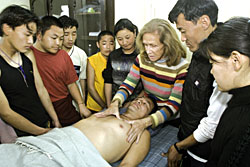|
|
Since the 10th century, highland healers have traditionally shared their knowledge in gatherings of healers from Kathmandu, Kashmir, Persia and Mongolia. "Tradition has always been a process of dynamic engagement," says Carroll Dunham, an anthropologist and an expert on Bon culture who has been living in Nepal for more than two decades studying Himalayan peoples.
Carroll also runs Wild Earth, a private company that produces a range of bath products from Himalayan herbs gathered from community-owned forests. Alternative healing, as it's known in the west, is one of the fastest growing industries in Asia and beyond.
This may be good news for economists but the growing interest in natural herbal remedies signals a challenge for traditional healing methods, products of age-old wisdom and centuries of on-the-ground testing.
Wild Earth is negotiating with its Middle East partner Wafi international and Shangri-la hotels in Asia that would see amchis work in the hotels for one-two years in exchange for their salaries and additional money sent to Lo Kunphen Medical School, the amchi training school in Lo Manthang. In effect, three amchis working abroad would support three others working in rural clinics in Upper Mustang. "Rather than flipping burgers in menial occupations abroad, Himalayan peoples could be respected ambassadors of their heritage," says Dunham.
Wild Earth is currently giving preventive health care training in the form of massage therapy to nine young amchis from around Nepal. Instructed by Joanna Claire (pictured) a specialist in acupressure who has been using Chinese healing techniques for almost four decades, the healers are learning two types of massage therapy based on the vital points used in Tibetan medicine.
"The purpose of this training is to work with the authenticity of Tibetan medicine using a modality that they have not been versed in," says Claire. The nine amchis have already completed at least eight years of classical training in the art of traditional healing, five of them in Mustang the others as apprentices to an established amchi in Kathmandu. Although that might have included some massage therapy, one of the new things they are learning, especially the women, is how to massage pregnant women using acupressure and hot stones.
What is most inspiring about these young healers is their desire to return to their rural highland homes to practice their medicine. Pema Dolma Bista, 20, is the daughter of the renowned amchi Gyatso Bista, the personal physician of the Raja of Mustang. She learnt the art of healing in Lo Kunphen but unlike many modern young doctors who wish to practise only in cities, Bista is going back. "We lack proper facilities and infrastructure in our village but we can only help if we go back," she says.
Thupten Ngudrup, 27, was born in Solukhumbu but has been living in Kathmandu training to be a Buddhist monk. He, too, wants to go back and apply the healing touch among his own people.
ALOK TUMBAHANGPHEY



